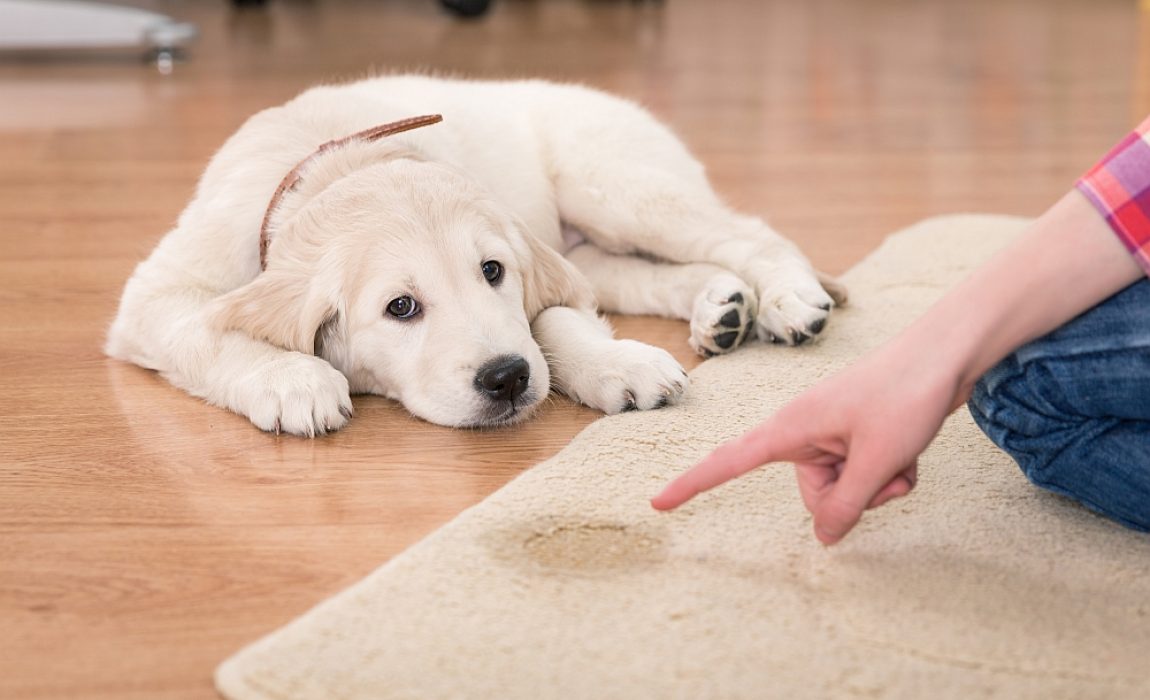…And when you finally bring that puppy home, you realise that your peaceful and well organised life is over… You’ve never thought that this tiny and fluffy ball of happiness would turn up to become a non-stop poop and pee providing mechanism…
In this article, we will discuss our expectations of having a puppy and the reality we often face. Quite often it happens that the normal puppies’ or dogs’ behaviours are considered as inappropriate by their owners or society and that’s exactly where we see a lot of risks for dogs being relinquished to shelters. However, most of the problems are preventable or curable. As many of you are already aware, I am a big fan of prevention as it is easier, cheaper and fair for dogs.

My name is James Grey, I am an accredited Royal Kennel Club Dog training instructor and I work as a dog trainer for the last 38 years. Since 2000, I started focusing on behavioural and emotional aspects of the dog for two main reasons:
– usual training was often not working and no one could explain me why;
– new studies about dogs’ behaviour, development and cognition became available and they opened a brand new page in dog training and dog-human relationships.
I became more interested in taking on board behaviour cases because I found it very important to dig deeper to see what lays inside of the dog with issues and how I can improve his quality of life. Now, I provide a dog-owner centred care where the relationships and dog’s emotional side are my top priorities. I often use a combined approach using training and behaviour modification techniques to get the best outcome from the dog.
In this blog, kindly offered to me by Lady Wimbledon, I will cover a few moments to support all potential and existing dog owners on their way into successful dog-human relationships.
In previous article we talked through about getting a puppy. In this session, we will talk about preventing a puppy from developing destructive behaviours and separation disorders. We will touch base about what to do if your puppy or dog has issues and where and when to seek help.
“Handle every situation like a dog. If you can’t eat it or play with it, just pee on it and walk away.”
Housebreaking
Soiling in the house is one of the main reasons for dogs being relinquished to shelters.
Unless you bring your puppy to a carpet floor, this particular training is surprisingly easy to sort. The only thing you would need to do is to take your puppy out as often as possible (I was taking my pup out every hour) and then gradually increase the gap between walks. Of course, if your puppy comes from puppy farmers, this is a different story as they are often being neglected there and got used to eliminate in the nest (think where you get your puppy from).
Switching to the outdoor toilet is a natural process. Once your puppy realises where to go, he starts holding until that moment. Accidents will happen from time to time but your job as an owner will be to stay calm and patient while wiping and cleaning the floor. You may or may not use some special pads and train your puppy to go there but given that you will start taking your puppy out in about 2-3 weeks’ time, I wouldn’t be much bothered about this. If you are using a playpen, it is even easier as the nest and toilet areas are different in case you are working and not able to walk your pooch every hour. It will still work well. If you have no playpen, you can use baby gates to block a part of the corridor or hall area where you can keep your puppy. I will discuss the use of playpen a bit later in this article.
What I wouldn’t suggest you to do is to use towels or other fabric materials for this particular training.
Another thing to avoid during this process is punishing a puppy in either physical or verbal way after the accident. This will only create more anxiety and stress in your pup and he will be less likely to hold simply because of fear while seeing you coming. Bear in mind, dogs do not remember the past the way we do. Once the accident occurred, it is too late for punishment anyway.
Take away: Patience and taking the pup out often do the job easily.
If you are working, use a playpen where the bed and toilet areas are different.
“Every snack you make, every meal you bake, every bite you take…I’ll be watching you.”

Separation disorder
Another major reason for dogs being given away to shelters. Alongside reactivity towards other dogs, clients with separation disorders are very common and I see them in my clinic on a daily basis. However, this is easy to cure in most cases and my portfolio is full of success stories and happy owners. I recall, I only failed once about 15 years ago when I was still more a dog trainer not a behaviourist. I didn’t have enough knowledge at that time. Well, I still have a feeling that I know nothing…
Let’s carefully talk things through.
All puppies will have issues with separation once you bring them from their family. It is very natural and understandable:
– New environment and smells – when I plan to get a puppy, at the age of 5 weeks I bring my worn t-shirt to the breeder so the puppy has my smell already there. When I collect a puppy at the age of 8 weeks, I get that t-shirt back with me full of familiar smells on it.
– No familiars around – the same t-shirt goes to the playpen plus local induction with treats and plays.
– Who are you? – I introduce myself with treats and plays so the puppy associates me with a pleasure quicker plus starts on easy going training during the play to establish a leadership role in a gentle manner.
As you can see, separation disorders are often caused by fear. Your puppy doesn’t feel safe in his new environment. The severity of this issue depends on many factors:
– genetically predisposed stronger bong with a family;
– possible health issues (puppy farms)
– fearful/shy dog.
Separation Disorder can be True or Learned.
True Separation Disorder is relatively rare and easy to recognise due to specific symptoms and intensity of their manifestation:
– excessive salivation (if in a cage, the dog can literally get drowned in his own saliva)
– trying to get through doors or windows (immediate risk of self-harm)
– panting
– soiling
– breaking down furniture
– excessive barking, howling
Importantly, usual training techniques will not work with True separation disorders and will often require a Veterinary professional input to prescribe medication to help with training – this is where I failed many years ago!
As I mentioned, the True cases are very rare but if you spotted any of the symptoms above, especially if the dog is in a high risk of self-harm, please contact an accredited dog/animal behaviourist and a Vet in your area to help your dog. Usually, the behaviourist will make a referral to a Vet to investigate and treat a specific matter.
Learned Separation Disorder is what we commonly see around and it is reasonably easy to sort out with a few simple solutions.
Unless there is an underlying health issue including hormonal imbalance, the cure will be pretty simple and straightforward – to teach your puppy that staying alone is not the end of the world. We use counter-conditioning techniques to change the puppy’s emotional perception of the event. Essentially, we teach a puppy to accept your departure if not as a pleasure but with an expectation of something else – nice, good and safe. We are dealing with emotions. If you remember yourself feeling unsafe or scared, you can figure out how much time it took for you – a person with a massive cerebral cortex and abilities to think things through – to calm down and get rid of phobias. For example, it took me a good year to get rid of my snake phobia many years ago when, after a traumatic event, I was not able to go to sleep without checking my whole house two-three times to make sure I have no snakes in wardrobes or under the sofa… PTSD at its best. And if it takes so much time for a thinking human being who should be capable of controlling his emotions, imagine how hard it could be for those who can’t think this through and rationale their approach! For the dogs, it takes longer as they are not able to manage their emotions. This is what our role is – to provide them with a tool to become resilient and overcome their natural fears in our complex human environment.
So, what about the cure? The same as with housebreaking, we are expected to be very patient and we start from leaving our puppy for seconds or minutes at the beginning. Below, is a usual formula I use when bringing a puppy home:
- Collect a puppy on Friday morning and either book an annual leave the whole next week or at least Monday. You will now have 4 days to start working with your pooch and normally it is sufficient enough to give a puppy an idea that staying alone is not too bad.
- Start practicing leaving your puppy in his playpen for a minute several times a day while providing with tasty chews/kongs. Gradually increase this time adding 5-10 minutes until you get to an hour. Most of the pups will cry when you leave but if you started with short intervals as described above, plus tasty chews, pups will get calm pretty quick.
Usual mistakes:
– Puppy left alone for hours straight away – this will not help him to feel safe. On the contrary, the puppy will likely become more anxious and hard to settle.
– You do not practice during the day and only leave your puppy alone at night. This will cause lots of stress if the puppy is not prepared for this yet. Some pups get easy to sleep overnight alone but are not trained to stay alone during the day.
– You hear a puppy cry and respond to this. Your puppy will quickly learn to cry and bark to bring you in. Therefore, when practicing leaving your puppy alone, only come back to him when he calms down, when there is even a short gap in between cries.
If unsure, this particular training is included in our puppy training course, so once you get your puppy, your trainer will attend your place to show you how to start teaching your dog in the right way.

Biting and nipping
Teething and mouthing are the other typical issues we see in pups. These are normal behaviours as puppies are learning how to use their mouth plus inflamed gums cause irritation and the need to chew anything in an attempt to soothe the pain. Bear in mind that dogs use their mouth basically the same way as we use our hands. That is why completely prohibiting a dog to use their mouth will likely cause a lot of frustration that may result in aggression towards the owner. Instead, we need to teach a puppy how to use his mouth and the power of jaws in the right way. The next time your puppy tries to attack your hands, you can either yelp in a high pitched voice and immediately keep your hands still (boring) so the puppy will not be interested any longer and give him a toy instead. Or, if you can tolerate the bites, you can let him play with your hands even more, letting him bite you, and quickly switch him to a toy. Whatever you do, do not prohibit biting completely because the dog will never learn how to use his mouth and in future can cause serious injuries during a normal play.
Usual mistakes:
Owners tend to take the hand away from the puppy prompting the latter to chase your hands even more. Keeping your hands still and motionless is a better solutions. Remember your parents telling you never run away from dogs!
Helpful tools to use.
– Kongs – stuff it with wet food, you can also add a few bites of cheese for smell, and freeze it. Stone frozen kongs are not only useful to train your pooch to stay on his own being busy getting the food out of it but also help to cool down the inflamed gums.
– Teddy bear – still the best friend of my dog. I usually buy one from the kids section in Tesco or Asda.
– Rope toys (not squeaky)
– Natural chews like yankers, pigs ears or bull pizzles would do the job as well.
The puppy and the kids…
This section is one of the most troublesome from my humble opinion. It is also very important for the puppy’s wellbeing and development because we talk about emotions and physical development of the brain under emotional (hormonal) influence.
From experience, I can say that most of the puppies raised in busy households with two or more young children were significantly harder to educate and training was taking much longer. But why? Because of emotions.
Parents tend to get puppies for their kids to grow together but the problem is that children grow much slower. It takes years. But it only takes a few weeks or months for a puppy. Here we have children that are not yet able to control themselves, and your puppy who is not controllable either. Both parties are getting overexcited within seconds, kids are running and puppy runs after them like a little furry shark with his teeth as sharp as knives… What do they learn from this experience? Kids will be afraid of the pup and a pup will learn to get excited with kids and will be harder to settle and accept any new learning. Another important moment is that kids will likely be very persistent in their attempts to engage with a puppy every now and then – when the puppy sleeps, when the puppy eats, when the puppy plays with his toys… Very soon your puppy will be grown up enough to protest and protect his own space and belongings. I’ve seen a lot of clients with their dogs developed guarding or possession aggressions towards children and were subjects for rehoming. However, this is completely preventable by following these simple rules:
1) When introducing a puppy to your children, the best solution is to use the baby gate. Unless you want your puppy to learn how to jump on children and people (which will be hard to stop later on, baby gates and playpens are the best solutions to get both parties to know each other.
2) When a puppy and children are together in one location, your role as a parent is to actively monitor them. Not only to be at the same place but to really watch them every second. If you are busy cooking or watching TV, the best solution would be to put a puppy in a playpen. Remember, puppies need to sleep for up to 16-18 hours a day for their best development. Constant agitation and excitement can cause physical damage to the brain the same way as some illicit drugs.
3) Teach your children how to teach your puppy. Very simply commands like Sit or Down, or Eyes will help them both to accept and respect each other as living beings. Dogs are not toys!
4) As mentioned above, puppies grow much faster. You only have weeks to create a solid foundation for their future life. Therefore, my usual advice is to focus on a dog’s education first. In this particular scenario children can wait as they have more time for development and education.
A special word to those families that plan babies and already have dogs with or without issues.
If your current dog doesn’t have any particular issues in general, you will still need to start preparing your pooch to new addition to your family in advance. Dogs do not think about kids as small people. For dogs, a child is a different species and requires some work around socialisation and careful introduction. Your preparation could include baby gates, space management, especially when the child is already at home, and active monitoring to avoid any possible conflicts between a dog and a baby.
If your current dog has issues (pulling a lead, generally disobedient, reactive etc), please call for help in advance! Dog training and modification of current behaviours are not something that can be resolved magically within a day or a month. You will need to work with a dog yourself (unless you decided to use residential training). This will require some physical exercises which can be difficult for ladies in waiting, especially if there is no one in a family who would train a dog.
A few words about a Playpen. Playpen is a safe environment that allows a puppy to avoid learning bad behaviours while staying safe without you constantly monitoring the dog. When we talk about training, the larger part of the job is to prevent bad things from happening. Dogs are opportunists and once they find something rewardable like surfing through the litter or chewing your shoes, it will be much harder to stop them. They have no capacity to understand between the right or wrong from your perspective. You can’t tell them either as they are not verbal like us. But if they have no chance to find out that chasing a child is rewardable, or picking up your sock is so lovely because it is always followed by the game of “chase me if you can”, then these behaviours will not be added to the pup’s repertoire and therefore not rehearsed and deeply learned.
In the next article we will talk about training and education and when and how we should start.
For more help & advice follow James Grey online or contact:
email: james@dogtrainingplanet.co.uk
Tel: 07724 776698
Web: https://dogtrainingplanet.co.uk/
Instagram: https://www.instagram.com/dogtrainingplanet/
Facebook: https://www.facebook.com/DogTraininginLondonuk
Youtube: https://www.youtube.com/channel/UCMJgK0R1AXPzy3puteV8Bnw






